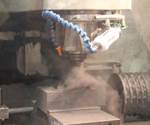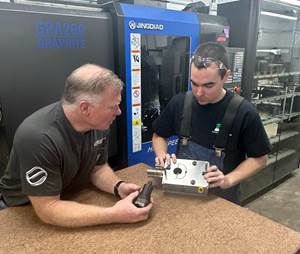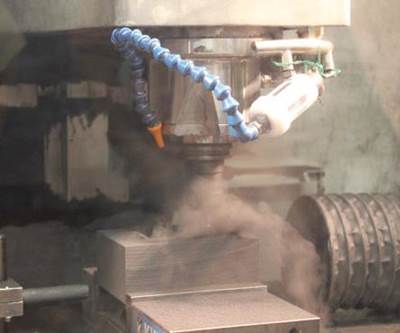How to Deal with Graphite Dust, Part 2
A review of the explosive potential of graphite dust and how to dispose of remnants that may be accumulating around the shop.
In part one of this article, we touched briefly upon possible health effects of graphite dust and that the type of synthetic graphite used for electrodes does not particularly pose serious health implications as long as adequate dust collection is used. We also examined two types of dust collection systems and the proper air flow to achieve maximum dust evacuation. In this article, we will look at the flammability or explosive potential of graphite dust.
Controlling Dust
When we think of controlling dust in the workplace we often consider how to reduce or eliminate the potential of inhaling dust particles to prevent health issues. Unfortunately, the consequences of a fire or explosion caused by accumulated dust in the workplace can be far greater.
Dust is an ever present condition in a manufacturing environment and generated by a myriad of processes that include production equipment, material handling and machining. The creation of this dust does not inevitably lead to safety and health risks if accumulation levels are kept within limits through effective housekeeping and dust collection practices. However, when excess amounts of dust are allowed to accumulate and then introduced to an ignition source, the results can be catastrophic.
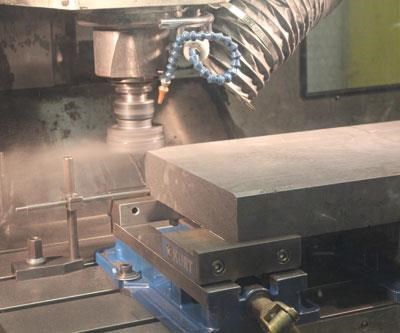
While a dust fire or explosion cannot be completely eliminated, the use of these practices significantly reduces the possibility of this occurring.
Explosive Potential of Graphite Dust
Dust explosions in manufacturing plants over the past decade have certainly gained media attention as these tragic events resulted in needless loss of life and property. The devastation of these events also caught the attention of the Occupational Safety and Health Administration (OSHA).
In 2008, OSHA Directive CPL 03-00-008 was issued and states, “This directive contains policies and procedures for inspecting workplaces that create or handle combustible dusts. In some circumstances, these dusts may cause a deflagration, other fires, or an explosion.”¹ As a result of this directive, facilities that generate dust through a number of processes, including machining graphite, should conduct an assessment of their practices to determine the potential of a dust explosion and develop practices to lessen the probability of this occurring. The primary objective of this assessment is to identify if dust particles are combustible and in concentrations sufficient to ignite.
Combustible dust is identified as, "Any finely divided solid material that is 420 microns or smaller in diameter (material passing a U.S. No. 40 Standard Sieve) and presents a fire or explosion hazard when dispersed and ignited in air."² The elements of fire include fuel, oxygen and ignition. A dust fire or deflagration occurs when sufficient concentrations of fine particulates are suspended in air and then exposed to a source of ignition such as a spark or welding igniter. This ultimately results in the igniting or combustion of the dust.
In regard to a dust explosion, two additional elements are added. These are dispersion and confinement. If the dust is dispersed in sufficient volume or a dust fire is in a confined area, then the potential of this developing into an explosion is significantly increased. Controlling any one of these elements will essentially eliminate the potential of a dust explosion. To overcome the potential of a graphite dust explosion, the industry has primarily relied on controlling the element of fuel by removing dust at the source through effective vacuum systems. However, this does not minimize the need to address each element and determine practices to mitigate its contribution to an explosion.
In order to increase its effectiveness in controlling the dust and reducing the potential for a fire or explosion, all dust control equipment involved in handling graphite dust should have explosion relief vents, an explosion suppression system or an oxygen-deficient environment. Having adequate general ventilation is the first step and should be sufficient to also limit the employee exposure to airborne contaminants such as graphite dust particles.³
Explosibility Testing
It is beyond the scope of this article to identify the full testing process in determining the explosive nature of graphite however; explosibility tests of graphite dust generated from the machining operations at a qualified laboratory were conducted.4 The results of this testing (see Table 1) will provide the customer with an indication of the explosibility for the graphite dust tested. However, due to variability in conditions, each customer will need to perform the explosibility testing for their conditions to have correct data to make a valid assessment of their activities.
The results of the laboratory tests indicate the graphite dust used in these tests are “hard- to-ignite” even with low moisture content and high concentration levels where 98.5% of the particles are less than 500 micron in size.
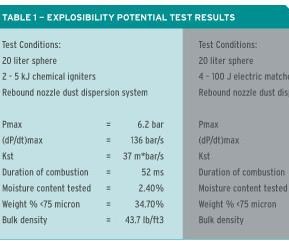
To reiterate, combustible dust is defined as a solid particle being 420 micron or smaller that can be ignited. In a shop environment, at the concentration levels of these tests the graphite dust would most likely be thick enough to hinder visibility. Therefore, the bottom line is that the potential of experiencing a graphite fire or explosion is minimal as long as good ventilation and sufficient dust collection is present, and effective cleaning and maintenance programs are utilized.
In some cases, additional information can be provided by the manufacturer. One possible source for information on combustibility is the Material Safety Data Sheet (MSDS) for the material. Hazard statements should be contained in each MSDS that identify if the material is a combustible product in its present form or a future transformed form. The MSDS will should also identify the exposure controls limits as well as the Hazardous Material Information System (HIMS) and National Fire Protection Agency (NFPA) rating. Contact your graphite supplier for a copy of the MSDS for your specific material.
Summary
Although the aforementioned tests conducted have shown graphite dust to be “hard-to-ignite,” this does not release companies from the responsibility of continual improvements in dealing with graphite dust. Recent times have seen the development of practices meant to improve the ability to identify an explosion risk. These practices often include safety monitoring equipment, improved dust collection systems and the implementation of an effective safety program that offers good housekeeping practices and an efficient preventive maintenance program.
While a dust fire or explosion cannot be completely eliminated, the use of these practices significantly reduces the possibility of this occurring. Being aware of the elements for a dust fire or explosion, knowing the explosive potential of the graphite dust and what resources are available for further information greatly improves the ability to identify potential risks and eliminate them before it is too late.
References
1 OSHA Instruction, Directive Number: CPL 03-00-008, Combustible Dust National Emphasis Program (reissued), http://www.osha.gov/pls/oshaweb/owadisp.show_document?p_table=directives&p_id=3830
2 National Fire Protection Association (NFPA). NFPA 654. Standard for the Prevention of Fire and Dust Explosions
from the Manufacturing, Processing, and Handling of Combustible Particulate Solids. 2006 Edition NFPA Inc. Quincy,
Mass. 2006. http://www.nfpa.org
3 MSDS: Poco Graphite Synthetic EDM Grade
4 Explosibility tests conducted by Poco Graphite
Related Content
Collaborative Engineering Drives Quality Mold Solutions
Advanced engineering and tooling teams collaborate to train, design, develop and deliver high-quality, cost-effective molds efficiently, ensuring perfect parts and faster launches.
Read MoreMold Builder Meets Increased Domestic Demand With Automated Cells
Burteck LLC experienced significant demand increases due to reshoring and invested in automated machining cells to step up its production output quickly and avoid losing business.
Read MoreFive-Axis Graphite Mill With Automation Debottlenecks Electrode Machining
Five-axis electrode cutting enabled Preferred Tool to EDM complex internal screw geometry on an insert that otherwise would have had to be outsourced.
Read MoreMMT's Most-Viewed Case Studies in 2024
Did you miss any of MoldMaking Technology’s most-viewed case studies from 2024? Now’s your chance to dive into these trending topics.
Read MoreRead Next
How to Deal with Graphite Dust, Part 1
A review of the characteristics and considerations when handling graphite dust.
Read MoreAre You a Moldmaker Considering 3D Printing? Consider the 3D Printing Workshop at NPE2024
Presentations will cover 3D printing for mold tooling, material innovation, product development, bridge production and full-scale, high-volume additive manufacturing.
Read MoreHow to Use Continuing Education to Remain Competitive in Moldmaking
Continued training helps moldmakers make tooling decisions and properly use the latest cutting tool to efficiently machine high-quality molds.
Read More
